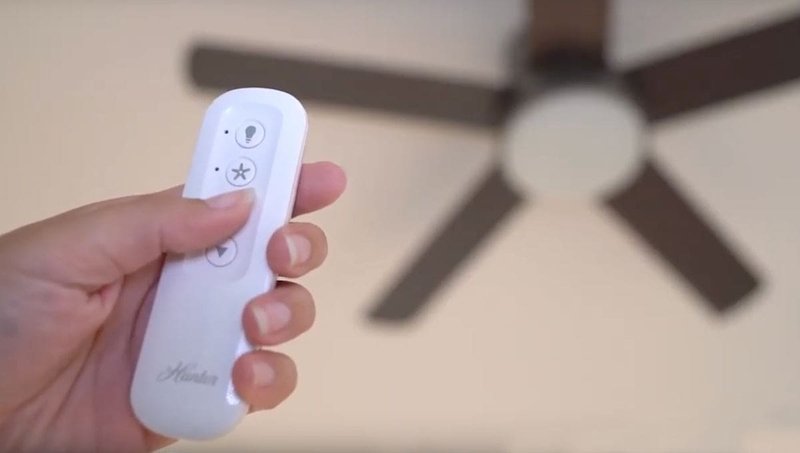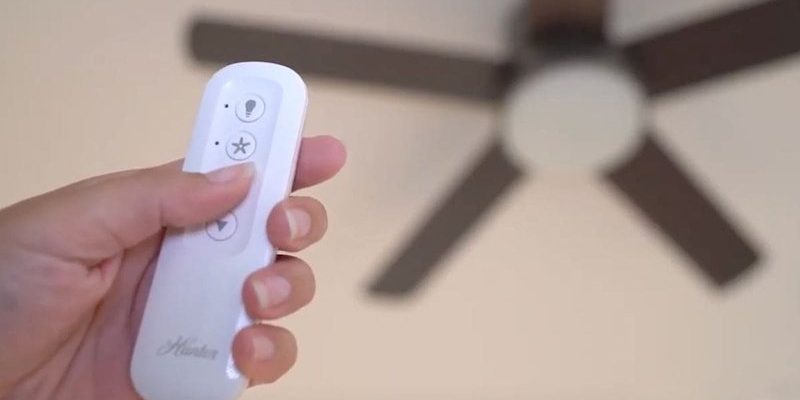
Hunter is one of those names that pops up a lot in ceiling fans, and their remotes usually work like a charm. They’re supposed to make life easier—no chain-pulling or standing on chairs. But when that magic button press suddenly stops doing its job, it feels a bit like losing the TV remote during the season finale: inconvenient, annoying, and slightly mysterious. Let me walk you through the common reasons your Hunter ceiling fan remote might not be working, and what you can do about it. It’s much less complicated than it seems, I promise.
Common Reasons a Hunter Ceiling Fan Remote Stops Working
When the Hunter remote stops responding, most people jump to conclusions about dead batteries. Sure, that’s the obvious place to start, but there are several other sneaky culprits. Sometimes, the issue is as simple as a loose battery cover or a button getting stuck. Other times, it’s something a bit more technical, like a pairing issue with the fan’s receiver.
You might be wondering: “Is it really just the batteries?” Honestly, it could be, but more often than not, it’s a perfect storm of simple things adding up. The battery contacts could be corroded, which means the remote isn’t getting proper power even if the batteries are brand new. Or, the remote may have lost its sync with the fan, which can happen after power outages or if you’ve accidentally pressed a certain combination of buttons.
Sometimes, interference from other electronics or even the design of your house can cause the signal to drop. For example, thick walls or having a Wi-Fi router nearby might mess with the remote’s signal. It’s easy to overlook just how many things can mess with a simple wireless signal. Let’s break down these common issues one by one.
How Hunter Ceiling Fan Remotes Communicate with the Fan
Before troubleshooting, it helps to know how the ceiling fan remote actually “talks” to your fan. Most Hunter remotes use either radio frequency (RF) or infrared (IR) signals. RF is more common—think of it like a secret handshake between the remote and a receiver tucked inside the fan canopy. IR remotes need a direct line of sight, but with Hunter, RF is the usual style.
Inside your fan, there’s a little electronic receiver that listens for commands from the remote. When you press a button, the remote sends a coded signal (a unique code so your neighbor can’t control your fan) that tells the receiver what to do: turn on, off, change speeds, or dim lights. If the code is wrong or if the receiver doesn’t get the message—for any reason—the fan ignores the command.
If you’ve ever installed a universal remote, you know the drill: syncing, pairing, and sometimes fumbling with tiny DIP switches inside the battery compartment. Hunter remotes are a bit more user-friendly, but if something goes out of sync, you’ll need to reset or pair them again. Take a deep breath—this part isn’t as scary as it sounds.
Checking the Hunter Remote’s Batteries and Power
Let’s get the obvious out of the way: dead or dying batteries. You’d be amazed at how many “broken” remotes just need fresh batteries. But there’s a little more to it with Hunter ceiling fan remotes. Here’s what to check:
- Battery orientation: Sometimes the batteries get put in backward, or they pop out slightly if the remote’s been dropped. Double-check the battery direction, and make sure they’re snug and properly aligned with the +/− symbols.
- Corrosion or debris: Peek inside the battery compartment. If you see any white or greenish gunk, that’s corrosion. It happens when batteries leak. White vinegar on a Q-tip can gently clean it, but if it’s bad, you might need a new remote.
- Contact points: The little metal springs or tabs inside the remote need to touch the battery ends firmly. If they’re bent or flattened, carefully pull them up so they connect better.
Replacing the batteries with a high-quality, fresh set is never a wasted effort. And yes, even if you bought a “new” pack at the grocery store, sometimes one or two are dead on arrival. Always swap in another set if you have doubts.
How to Reset or Re-Sync Your Hunter Ceiling Fan Remote
Here’s the thing: just like computers, remotes and fans sometimes need a reset to start communicating again. If the remote’s light blinks but the fan ignores it, you might have to re-sync (or pair) them.
To reset most Hunter ceiling fan remotes, follow these steps:
- Turn off power to the fan at the wall switch or circuit breaker. Wait about 10 seconds. This fully “clears” any stuck signals.
- Turn the power back on. Quickly press and hold the “fan” or “power” button on your remote within 30 seconds. Some models need the “pair” or “sync” button, so check your remote for a hidden button inside the battery cover.
- Wait for the fan to respond. Usually, the fan’s light will blink or the fan will spin a little to show it’s paired.
If your fan and remote aren’t playing nice after that, try resetting one more time. Some Hunter fans use DIP switches—tiny toggles inside the remote and receiver that must match for the code to be right. If you’ve changed batteries or added another Hunter fan nearby, mismatched switches can cause major confusion. Make sure they match exactly!
If you’re lost, always peek at your fan’s manual. Hunter’s instructions sometimes hide these steps in the tiniest print, but they’re gold when things get weird.
Troubleshooting Interference and Signal Issues
Wireless signals aren’t perfect. They can bounce off walls, get blocked by furniture, or get jammed by other electronics. If your Hunter remote works sometimes, but not others—or only when you’re *right* under the fan—signal interference might be the villain.
Common culprits include:
- Wi-Fi routers and smart home devices: These gadgets use similar radio frequencies. If your router sits near the fan, try moving or repositioning it.
- Metal fixtures and mirrors: Metal reflects radio signals, which can scatter or weaken them. Oversized light fixtures or wall mirrors near the fan can make things worse.
- Walls and floors: Thick walls, especially cement or brick, can block the remote’s signal. Try standing closer or pointing the remote in different directions.
If the signal is still weak, try replacing the remote’s batteries *again*—low battery power can limit the distance the signal travels. If all else fails, it might be worth testing the remote in another room (if you have a similar fan), or bringing in a universal remote designed for ceiling fans. Sometimes, the only way to confirm a remote is dead is to swap it with another working one.
Hunter Ceiling Fan Receiver Problems and How to Fix Them
Here’s a scenario: you’ve changed the remote’s batteries, reset everything, and still—nothing. This is often when people forget about the receiver inside the fan. If the receiver goes bad, the remote can’t talk to the fan no matter what.
Receivers can burn out over time, especially if there’s a nearby power surge. The symptoms? The fan and light both ignore the remote’s commands, but the manual wall switch works just fine. (If nothing works, the fan itself might have a bigger electrical problem.)
To check or replace a bad receiver:
- Turn off the power at the circuit breaker. Don’t skip this—safety first.
- Remove the canopy (cover) on the ceiling fan. The receiver is usually a small black or white box inside.
- Look for obvious signs of damage. Burn marks, melted spots, or loose wires are bad news.
- If you’re handy: You can order a new Hunter receiver online, but make sure it matches your model number exactly. Replacing it just means unplugging the old one and connecting the wires the same way. If you’re not comfortable, call an electrician. No shame in that!
Sometimes, resetting the receiver (unplugging, waiting, and plugging back in) can bring it back to life, but if it’s physically damaged or still unresponsive, a replacement is your best bet.
Comparing Hunter Remotes to Universal Ceiling Fan Remotes
You might be curious about using a universal ceiling fan remote instead. Universal remotes can be a lifesaver if your original Hunter remote gets lost, broken, or just plain stubborn. But there are some quirks to be aware of.
Hunter remotes are designed with specific codes and features in mind. That means things like dimming, variable speeds, and special light programs are tailored to the Hunter receiver in your fan. Universal remotes work by mimicking the basic commands (on, off, speed, light), but they might not support every custom feature your Hunter fan offers.
On the plus side, universal remotes are easier to find at hardware stores and often cost less than official Hunter replacements. The pairing (or “learning”) process is usually straightforward—but you’ll still have to match DIP switch settings if your fan uses them, or follow the pairing/reset process described earlier.
If you’re using a universal remote and it isn’t working, double-check compatibility with your exact Hunter model. Sometimes, a universal remote will partially work—maybe it turns the fan on but can’t dim the lights or change speeds. In those cases, you’re better off sticking with the Hunter-branded replacement, even if it costs a bit more.
What To Do If Your Hunter Ceiling Fan Remote Still Isn’t Working
At this point, you’ve tried everything: fresh batteries, reset and re-synced the remote, checked for interference, and maybe even eyed that receiver inside the fan. If your Hunter ceiling fan remote still isn’t working, it might finally be time to call in reinforcements.
Here’s what I’d suggest next:
- Contact Hunter customer support. They can confirm the part numbers, walk you through advanced troubleshooting, or tell you if there’s a recall on your remote or receiver.
- Order a replacement remote or receiver. Always use your fan’s exact model number when searching for parts.
- If your fan is under warranty: Don’t fix it yourself. Let Hunter’s support team handle the repair or replacement.
- If all else fails: Consider using the fan’s manual pull chains or a compatible wall control until you sort out the remote issue.
Sometimes, electronics just stop working for reasons that make no sense until you swap out a part or let a pro take a look. You’re not alone if you’re banging your head against the wall—remote controls can be finicky little things!
Wrapping Up: Getting Your Hunter Ceiling Fan Remote Working Again
When your Hunter ceiling fan remote stops working, it’s usually something small—a battery, a reset, or a little code hiccup. Occasionally, you’ll run into trickier issues like interference or a worn-out receiver. The good news? Most problems have simple fixes if you follow the steps carefully and don’t rush.
If you ever get stuck, Hunter’s manuals and support team are surprisingly helpful. Sometimes you just need a nudge in the right direction or a reminder not to overthink things. After all, nobody wants to sweat it out because of a stubborn remote.
Hopefully, you’ll have your fan—and your comfort—back under control soon. And maybe next time the remote goes dark, you’ll know exactly where to start.
